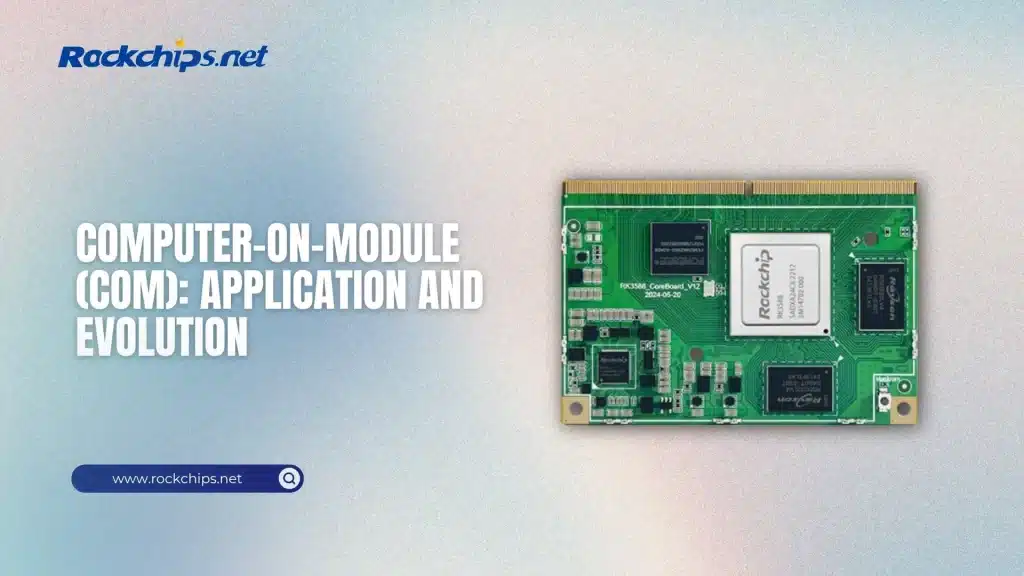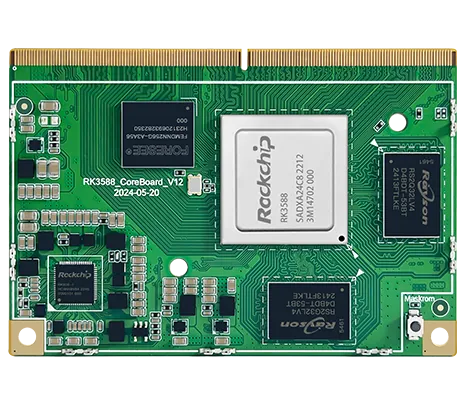
A computer-on-module (COM) is a form of single-board computer (SBC) and a specialized type of embedded computer system. Building upon the ideas of system on chip (SoC) and system in package (SiP), a COM operates as a middle ground between a complete computer and a microcontroller. It is closely related to a system on module (SOM).
Design of COMs
Computer-on-Modules (COMs) are fully integrated embedded computers built on a single circuit board. They are centered around a microprocessor that includes RAM, input/output controllers, and all necessary features to function as a complete computer. Unlike single-board computers, COMs typically do not have standard connectors for peripherals directly attached to the board. Instead, they are usually mounted on a carrier or baseboard, which provides access to standard peripheral connectors. Some COMs incorporate peripheral connectors directly, and certain models can operate without a carrier. COMs offer a compact and dense computing solution ideal for small or specialized applications, especially where low power consumption or limited space is required, such as in embedded systems. Due to their high level of integration, even complex CPUs, including multi-core processors, can be implemented on a COM. Some models also include field-programmable gate array (FPGA) components, allowing additional customizable functions via IP cores either on the COM itself or on the carrier card. This modularity enables easy adaptation of I/O functions to specific needs without extensive rewiring. A “computer-on-module” is also referred to as a “system-on-module” (SOM).
For example, you can check the last rockchip COM by Kiwi PI – Kiwi Pi CM5.
History
The terminology “Computer-on-Module” and “COM” itself was introduced by VDC Research Group, Inc. (originally Venture Development Corporation) to categorize a specific group of embedded computer boards. Dr. Gordon Kruberg, the founder and CEO of Gumstix, is recognized for developing the inaugural COM, which predates subsequent notable COM models by nearly 18 months. Gumstix’s ARM Linux Machine number 373 was launched on September 9, 2003, followed by Kontron’s number 735 on April 18, 2005, and Keith & Koep’s (now part of SECO) numbered 776 on June 20, 2005. Modules with numbers below 373 were generally larger, single-board computers like the Itsy, a compact handheld device based on the StrongARM processor. The rapid development approach pioneered by Dr. Kruberg – combining COMs with expansion boards – has remained central to cutting-edge innovation and has been adopted by major consumer electronics firms globally. COMs have played a key role in igniting entire industries that demand swift development cycles; notably, in 2005, Apple utilized a Gumstix COM to prototype the original iPhone.
Comparison Table: Common Computer-on-Module (COM) Standards
Advantages of Integrating Computer-on-Module
Utilizing a carrier board offers numerous advantages, such as integrating specialized I/O interfaces, memory modules, connectors, or custom form factors. This separation of the carrier board from the computer-on-module (COM) design fosters greater modularity, allowing for flexible adjustments when needed. While designing a carrier tailored to a specific application can entail significant development effort, placing the main processor and I/O controllers on a COM simplifies future upgrades – such as swapping out the CPU – without the need to redesign the entire carrier, thus saving both time and costs. Nonetheless, to ensure seamless upgrades, the board-to-board connection between the COM and its carrier must remain compatible over different iterations.
Opting for COM modules over custom-designed solutions also accelerates time to market, mitigates risks, lowers overall costs, offers a diverse selection of CPU options, and reduces the workload for customer-specific development. Additionally, it enables simultaneous hardware and software development, streamlining the entire deployment process.
